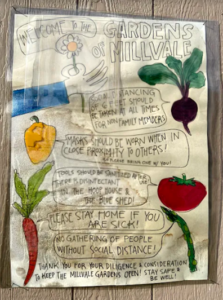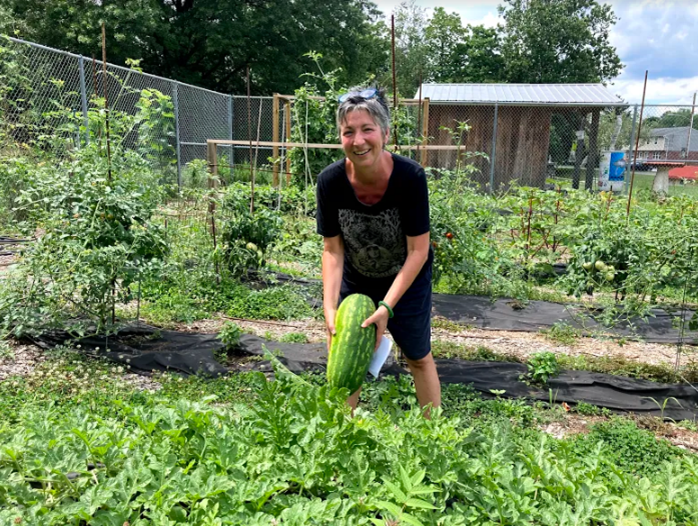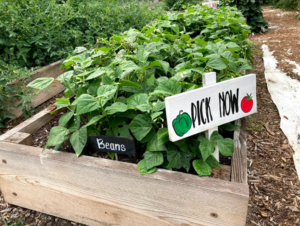Each August, our Community Projects team travels all around Allegheny County to visit with each of the now 33 community gardens that have graduated from our two-year community garden program over the past 11 years. These visits give us the chance to not only get out of our (home) offices, but more importantly, hear from the gardeners at each site about how the season is going. We bring with us a checklist of questions to learn about any infrastructure needs that they may have and any ways that we may be able to offer ongoing support through the Community Garden Network, the Sustainability Fund, and other programming. We also take a survey of the amount of growing space they have to help us estimate the amount of food they’re growing there and what sustainability features they’ve included in the gardens such as pollinator gardens, rainwater collection, and compost systems.
may have and any ways that we may be able to offer ongoing support through the Community Garden Network, the Sustainability Fund, and other programming. We also take a survey of the amount of growing space they have to help us estimate the amount of food they’re growing there and what sustainability features they’ve included in the gardens such as pollinator gardens, rainwater collection, and compost systems.
What we encountered this year were many groups talking about how the global pandemic affected neighbor engagement. Time and time again, gardeners expressed the slow start to their growing seasons this year. Many garden organizers shared sadness about cancelling public programming and volunteer days, especially because those events are such a big part of community building. At Planted in Homewood, the garden organizers weren’t able to do many of the programs they had hoped to this year, such as youth summer camps, but they shifted their energy into growing more food and working on expanding their pollinator garden.
Some gardens are struggling more this year due to the lack of programming and large volunteer groups and also the general stress on garden organizers. If there is a garden near you and you can provide some assistance with site maintenance or supplies, please check in with the growers and see if there is something specific they need. For gardens looking for low maintenance strategies, check out the recording of a workshop we offered earlier this year.

Crafton Community Farm Coordinator Andrea showing off some impressive watermelons growing at the garden.
Gardens with a primary focus on donating produce expressed a greater volunteer interest and a greater need at their local food pantries. Cosmetic upkeep at the garden has taken a backseat to food production. Crafton Community Farm is on track to grow over 1,000 lbs of produce this year for the Crafton Ingram food pantry!
Nothing is going to waste at the Greg Blythe Friendship Garden in Tarentum; most of the produce is picked directly by residents who need it. The Rosalinda Sauro Sirianni Memorial Garden in Bellevue had way more volunteer interest this year than before and has needed to turn folks away in order to keep the gardeners safe and working socially distanced. Coraopolis Community Garden’s parent organization is planning a major expansion of their local food pantry to meet the need.
Most gardens with individual plots had a longer waiting list this season, so if you are interested in joining a garden in 2021, reach out sooner than later!

As for the gardens themselves, this summer was very dry. Garden beds are showing signs of soil compaction and plant stress. We recommend adding a couple inches of compost to garden beds this fall or early spring, mulching beds with straw or shredded leaves to hold moisture, using a broadfork to break up compacted soil, and planting cover crops to reduce compaction and erosion.
We also witnessed many raised beds in need of repair on our garden visits. The primary cause of beds falling apart is weak corners. We recommend installing 4×4” posts on the inside of each corner and screwing heavy duty lag screws or structural screws into those posts. Do not screw one side board into another side board. See our PDF resource on raised beds here. Alternatively, you can use L-brackets to shore up beds that are pulling apart at the corners.
Fruit trees in need of pruning was another common theme. Late winter is the best time to prune those trees so you have time to plan now! Michael Phillips’ The Holistic Orchard is a great resource. A good rule of thumb is to first remove any branches that are dead, diseased, or damaged. Then remove any branches that are rubbing against each other, growing toward the center of the tree, or growing straight up (called water sprouts). Oregon State Extension has a great resource demonstrating how to cut branches properly so that you don’t damage the tree. Lastly, mulch the tree with 2-3” of shredded bark mulch or shredded leaves, making sure not to “volcano mulch”.
Thank you to all the gardeners who met with us this summer to share their successes and challenges. Established gardens can increase community engagement, food production and positive environmental impact with additional investment, and we are continually adapting our programming to increase support to these gardens that have graduated from our programs.
